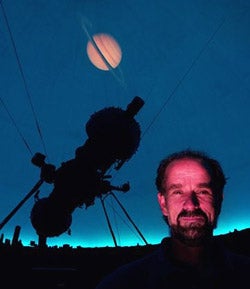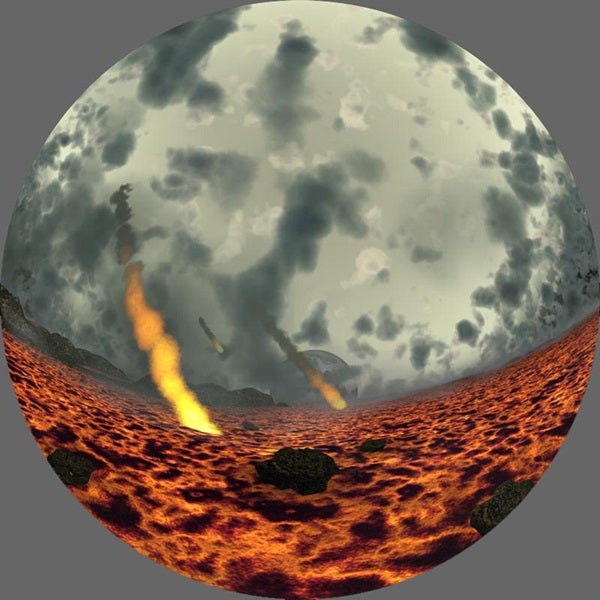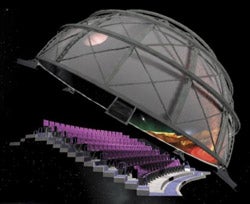“It’s kind of funny that they don’t understand we’re looking for a natural kid,” Bonadurer, says with a laugh.
Long before he hires the narrators, screens the soundtrack, or animates a single asteroid, Bob’s star shows, as he calls them, must be hatched.
“I like to come up with an idea for a show and let it germinate for about 3 to 4 months — you want to let it percolate a little bit,” explains Bonadurer. You also want to get it approved and funded.
It’s not as easy as it sounds. The shows that win approval are the ones that appeal to the masses. Although Bonadurer is a genuine space explorer, the folks who see his shows are not.
That’s why Bob actually interviews them for ideas. It’s part of his percolation process.
“You ask people, ‘What do you think about life out there in the universe?'”
Bob says he wants the thoughts of “someone who has no training in it” in order to make the sky shows understandable and exciting for the average guy. “You try to get their perspective,” he says. For Bob’s latest show, CSI: Cosmic, The Search for Life in the Universe, the man-on-the-street perspective makes the show’s theme more relatable.
“Some people think science is something different or hard. What we try to do is relate that science is like everyday life. The latest idea with the CSI: Cosmic is that, well, that’s nothing more than investigating, detecting, and that’s what scientists do. They investigate. They detect. They look for things. They look for answers. We do it all through our days. We don’t even realize it sometimes.”
Bob, on the other hand, is aware of what he’s looking for: a gripping half-hour that will leave his audience wanting more. That’s why he spends so much time developing his ideas, reading four or five books per topic, sometimes calling authors for one-on-one tutorials.
“The first three months is collecting ideas, letting them come to you,” Bonadurer says. “And the next three months, you’re doing more research, and you’re writing the script, and getting it all out on pieces of paper.”
“I liken a planetarium production to a very visual documentary, in a sense,” Bonadurer says. “We have to hire a narrator, we have to hire a musician. You can write a great script, and you can have wonderful visuals, but if you don’t have the right music and pacing for the show, your audience can fall asleep.”
Another hallmark of Bonadurer’s shows is audience participation. For planetarium patrons, it’s active learning. For Bonadurer, it’s a devastating weapon against star show slumber. “We try to spice it up and challenge the audience sometimes. We’ve actually made the audience move. Stand up. Pull coins out of pockets to demonstrate an eclipse.”
Even though Bonadurer searches for clever ways to engage his audience, he knows that, “less is more sometimes.” He laughs, remembering his early years of making planetarium shows. “You need to have a willingness to leave it on the cutting room floor!”
He confesses, “that was the hard thing to learn when I first started out in this business. Anything you wrote or developed visually through artists or animators you wanted to use…you wanted to not let go!”
But sometimes, he would have been better off letting go. Despite loads of research and months of devotion, Bonadurer has had some bombs.
“Your feedback is just watching them come out of the show. If they kind of look down at the ground and shuffle past you, you’ve missed it.” On the flip side, he’s had some blockbusters. “If they look you in the eye as they come out and say, ‘Great show,’ then you know you got it.”
Those are the days when it’s been worth shooting for the stars. “You’re on cloud nine. It’s a wonderful feeling. You hope people come back. The best advertising is word-of-mouth.”
Bonadurer hopes he gets a lot of that after all the time he’s poured into preparing his newest show. “It probably comes close to one orbit around the Sun —about a year,” he says, adding up his work hours. “Three months to germinate, 3 months to write it, and then 6 months basically to put it all together.”
The last thing is always the narration. “Once you narrate, it’s set in stone,” Bob says.
And you’d better be sure before you bring on the stage parents.
Rebecca Kleefisch is an award-winning freelance writer and producer whose work has appeared on the Lifetime Network, Living on the Lake Magazine and Lake Country Magazine. She is a former News Anchor for WISN-TV in Milwaukee, WI and the mother of two children with astronomical curiosity!”












